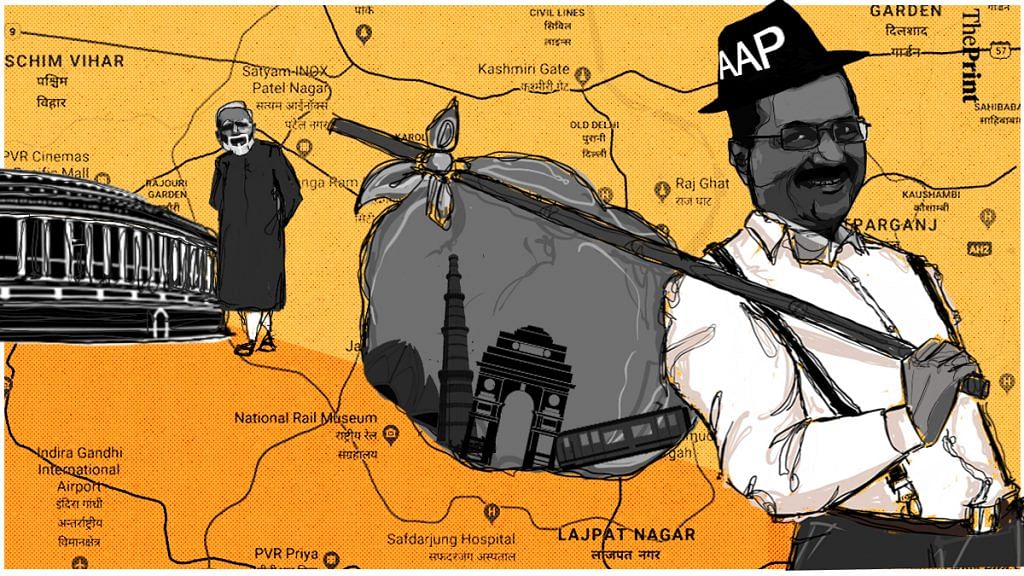The Modi wave left every non-NDA political party, regional or national battered and devastated, with the exception of one and a half. M.K. Stalin’s DMK is the one. Andhra’s YSRCP we count as a half because its wagon is hitched halfway to the BJP anyway.
The rest, especially the Congress, were hit so badly, none has yet shown a strategy or route to recovery, or display a willingness to regroup. With one exception: Arvind Kejriwal’s Aam Aadmi Party.
Let’s begin with the numbers of the 2019 Lok Sabha polls in Delhi. Aam Aadmi Party was the worst sufferer as it emerged number two in just 23 of the 70 assembly segments, never mind that it had won 67 of these in 2015. Even the Congress succeeded in topping five, mostly Muslim-dominated segments. Congress — which was reduced to zero in the assembly in 2015 — came second in 42 of 70 seats. The end of AAP in Delhi was written on its walls.
Check out the change in the air. And we aren’t referring to air quality which a CSE (Centre for Science and Environment) study showed as having improved significantly. If you sniff the political air, you can feel three changes: One, that AAP is fighting back. Second, that for now the divided Delhi BJP is still unsure whether it wants to risk making Delhi a Modi versus Kejriwal fight, just in case. And third, that the Congress is almost back to 2015: Non-existent, no leader, no morale.
We are not yet saying that AAP is poised to win a second term. But they are in the ring, up on their feet, and ready to resume the fight. That is unlike the Congress, for example in any of the three states voting in the next couple of months, although it finished a respectable second in all in the Lok Sabha polls.
Other regional parties, YSRCP, K. Chandrashekar Rao’s TRS and Naveen Patnaik’s BJD, don’t count as they are mostly backing the BJP and to that extent have ceased to be opposition parties. Further, these weren’t demolished by the BJP like AAP in Delhi. Nor do they face another election against the BJP in the next six months.
Kejriwal’s turnaround is comprehensive. In the past, he and his party had made it a habit to mock Modi. He had infamously called him a ‘coward and a psychopath.’ After the results, we have heard nothing rude. Or, in fact nothing but polite compliments for the prime minister and his government.
Also read: Kejriwal is trying to be Delhi’s ‘Chhota Modi’. Now, we wait for the elections
On 21 June, he personally went to congratulate the prime minister, wrote a nice tweet afterwards, offered to cooperate with the Centre. Since then, he and his government have picked up no fight or argument with the Centre. The transformation of the peskiest street-fighters of Indian politics into obedient schoolboys has been as dramatic as that of the state of Delhi’s government schools under their government.
This isn’t weakness or defeatism. It is politics. Unlike the Congress, Kejriwal accepted the reality of today’s politics fully: At this point, nobody can afford to oppose or attack Modi ad hominem. His priority, therefore, is not to be seen as Modi’s enemy. He doesn’t want the Delhi voter to go to the booths in February choosing between him or Modi.
His retreat from the fight with Modi is total for now. He also does not want to fight on any national issue. Do note his immediate and ready support to the Centre’s big changes in Kashmir, including diminishing it into a union territory. There wasn’t a whimper of complaint, just compliments and support from AAP to the Modi government on this. Never mind AAP’s ‘core’ demand for statehood for Delhi. You can call it hypocrisy if you want to be judgmental about politics. But in real life, smart politics.
The party has launched a publicity blitz. All of it is over local issues and what the party is constructively doing about them, not complaining of not being allowed to work as in the past. From schools, to electricity, water, air quality, CCTV cameras, free bus rides for women, dengue, even free pilgrimages for senior citizens. Soft religiosity (not Hindutva) and hard nationalism are both in play.
The old legend of Shravan Kumar has been pulled out of Hindu lore of a dedicated son ferrying his aged parents on his shoulders for pilgrimages. And the schools have now added a course on ‘deshbhakti’ (patriotism) in their curriculum, including stories about familiar Kargil war heroes.
Simply stated, the post-May 2019 AAP won’t let this election become about Modi, nationalism or religion. It will ensure that it is on the same side as the BJP on all three. They want to fight the coming Delhi election essentially like a civic body, a mayoral election. This also means that the party’s national ambitions have for now been mothballed. Again, excellent politics.
In the introduction of Anticipating India, published in 2014, I had expressed a hope. That the three key characters in our politics: Modi, Rahul Gandhi and Kejriwal, will all evolve. “Modi towards moderation,” I wrote, “Rahul may shed some diffidence and Kejriwal may find some establishmentarian calm.” The first two, you know better. On the third, there is vindication for now.
If Kejriwal continues to build on this and wins a second term that still looks distant but no longer out of his reach, he would have proven another point (in the same 2014 book) right: He’s no comedian or maverick like Raj Narain who defeated Indira Gandhi in Rae Bareli in 1977, I had written, he’s a challenger of substance in the long run, a lambi race ka ghoda.
Also read: To use or not use Modi’s face against Kejriwal in Delhi polls. BJP can’t decide
